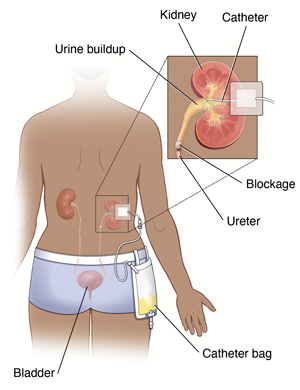Discharge Instructions for Percutaneous Nephrostomy
You had a procedure called percutaneous nephrostomy. This means that urine was drained from your kidney to prevent pain, infection, and kidney damage. You had the procedure because your kidney or the tube leading from the kidney to the bladder (ureter) was blocked by a kidney stone or tumor, or perhaps due to another problem. The blockage caused a backup of urine in your kidney.
A thin, flexible tube (catheter) will stay in place until the problem that caused the buildup of urine has been treated. This may be as soon as a day or as long as weeks to months. The catheter bag is taped to your leg so that you can walk around.

Activity
-
Don’t lift anything heavier than 10 pounds until your healthcare provider says it’s OK.
-
Don't do any strenuous activities, such as mowing the lawn, vacuuming, playing sports, or anything that will cause your tubing to be pulled or moved.
-
Slowly increase your activity level with short, frequent walks 3 to 4 times a day.
-
Don’t drive while you are still taking pain medicine. Wait until your healthcare provider says it’s OK to drive.
Home care
-
Eat your normal diet.
-
Drink 8 to 12 (8-ounce) cups of liquid each day unless you were told to limit liquids because of another condition. About 30 to 60 milliliters of urine should drain into the bag each hour.
-
Wear loose, comfortable clothes that won’t pull or kink the catheter tube.
-
Check your dressing often to make sure the tubing is secure.
-
Don’t let the drainage bag hang freely, or it will pull on the catheter. Keep it secured to your leg or hold it temporarily.
-
Empty the drainage bag often to keep the weight of the bag from pulling on the catheter.
-
Empty the bag when it is 1/2 to 2/3 full.
-
Always empty the bag before you go to bed.
-
Wash your hands before and after emptying the bag.
-
Measure and record the amount and color of the urine in the bag.
-
Gently clean the skin around the catheter with mild soap and warm water. Check the skin for any signs of infection. Pat dry with a clean towel.
-
Change your dressing if it becomes loose, moist, or dirty. Ask your healthcare provider how your skin should be cleaned and which skin barriers and attachment devices to use. Ask someone to help you care for your nephrostomy tube and follow the cleaning instructions.
-
Throw away the used dressing in a plastic bag.
-
If you were asked to stop any medicines before the surgery, ask the healthcare provider when you may start taking them again. This is especially important in the case of blood thinners (anticoagulants or antiplatelet medicines).
Follow-up care
Follow up with your healthcare provider, or as advised. If you need to have your nephrostomy tube in place for a time, you will need to schedule an appointment to have the tube changed every 2 to 3 months. Otherwise, you will need to schedule an appointment to have the tube removed. Your healthcare provider will tell you when this needs to happen.
When to call your healthcare provider
Call your healthcare provider right away if you have any of these:
-
A catheter that is not draining
-
The catheter comes out (don't try to put it back in.)
-
The catheter partly comes out. There may be a black mark on the tube to mark the place where the tube enters the skin. Check to see that the black mark is next to the skin. If the black mark isn't next to the skin, the tube has moved. A healthcare provider needs to put it back in. Don't try to put it back in.
-
Pain, redness, or discharge around the catheter
-
Fever of 100.4°F ( 38°C) or higher, or as directed by your healthcare provider
-
A noticeable increase or decrease in the amount of urine that drains
-
Cloudy or smelly urine
-
Urine that changes to a pink or red color
-
More pain
-
Severe pain in your side
-
Nausea and vomiting
-
New or worsening symptoms
Online Medical Reviewer:
Raymond Kent Turley BSN MSN RN
Online Medical Reviewer:
Rita Sather RN
Online Medical Reviewer:
Walead Latif MD
Date Last Reviewed:
11/1/2022
© 2000-2025 The StayWell Company, LLC. All rights reserved. This information is not intended as a substitute for professional medical care. Always follow your healthcare professional's instructions.